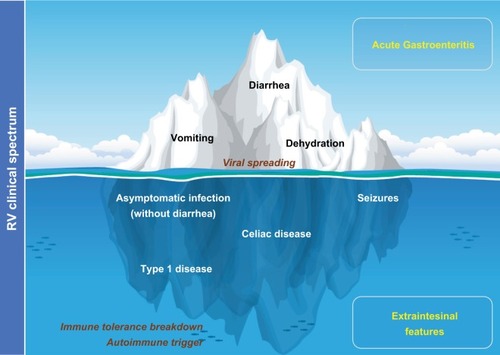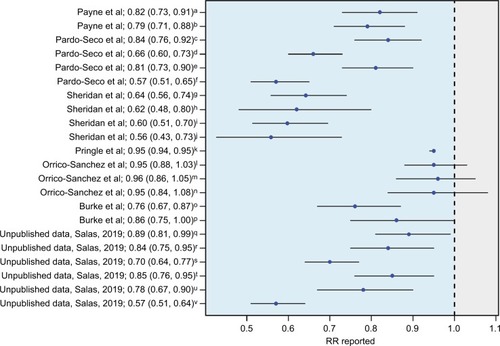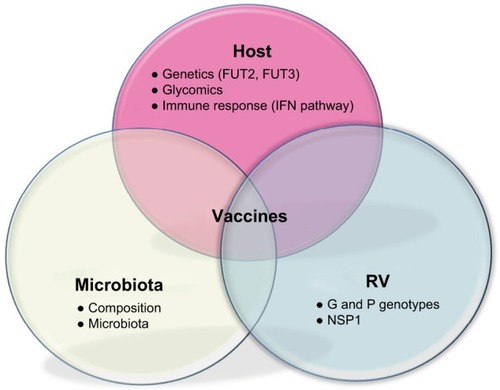Figures & data
Figure 1 The “iceberg” model of RV infection proposal: AGE and diarrhea are just the most obvious and frequent clinical picture of the pathology by RV.
Notes: Systemic viral spreading occurs and might produce several other extraintestinal manifestations such as seizures in the CNS (). Moreover, RV infection may be a trigger for the development of autoimmune pathology in individuals with a specific genetic background through a proposed mechanism of immune tolerance breakdown at early ages.
Abbreviations: AGE, acute gastroenteritis; CNS, central nervous system; RV, rotavirus.

Table 1 Extraintestinal manifestations of RV infection.
Figure 2 Data from different studies indicating the relation existing between RV vaccination coverage and seizures/convulsions expressed as RRs and their 95% CI.
Notes: RR values below one suggest a heterologous effect or an unforeseen direct effect of the RV vaccine that would favor a lower incidence of seizures/convulsions in the child population. aPayne et alCitation4 first-ever seizures; bPayne et alCitation4 all seizures; cPardo-Seco et alCitation3 (AKS) in year 2007; dPardo-Seco et alCitation3 AKS in year 2010; ePardo-Seco et alCitation3 convulsions in year 2007; fPardo-Seco et alCitation3 convulsions in year 2012; gSheridan et alCitation72 any emergency department presentation; hSheridan et alCitation72 any hospital admission; iSheridan et alCitation72 first emergency department presentation; jSheridan et alCitation72 first hospital admission; kPringle et alCitation73 seizure rates; lOrrico-Sánchez et alCitation38 vaccine coverage 1%–19%; mOrrico-Sánchez et alCitation38 vaccine coverage 20%–39%; nOrrico-Sánchez et alCitation38 vaccine coverage >39; °Burke et alCitation74 full vaccination; pBurke et alCitation74 partially vaccinated; Unpublished data AKS and RV vaccination coverage 1%–14%; Unpublished data AKS and RV vaccination coverage 15%–29%; Unpublished data AKS and RV vaccination coverage >29%; Unpublished data convulsions and RV vaccination coverage 1%–14%; Unpublished data convulsions and RV vaccination coverage 15%–29%; Unpublished data convulsions and RV vaccination coverage >29%.
Abbreviations: AKS, all kinds of seizures; RV, rotavirus.

Figure 3 Interactions in RV pathology: host, microbiota and RV.
Notes: Host background includes genetics through expression of histo-blood groups in epithelia, glycomics with the importance of sugars for RV interaction with host cells, and the IFN pathway, key in immune host defense. Intestinal microbiota composition and metagenome influence the course of RV infection through interactions between commensal microbial flora and pathogen. RV proteins (VP4 and VP7) determined by G and P genotypes and enterotoxin NSP1 play an important role in RV attachment, cell internalization and pathogeny. Overall, effectiveness of RV vaccines may be influenced by all these elements.
Abbreviations: IFN, interferon; RV, rotavirus; NSP1, nonstructural protein1.

